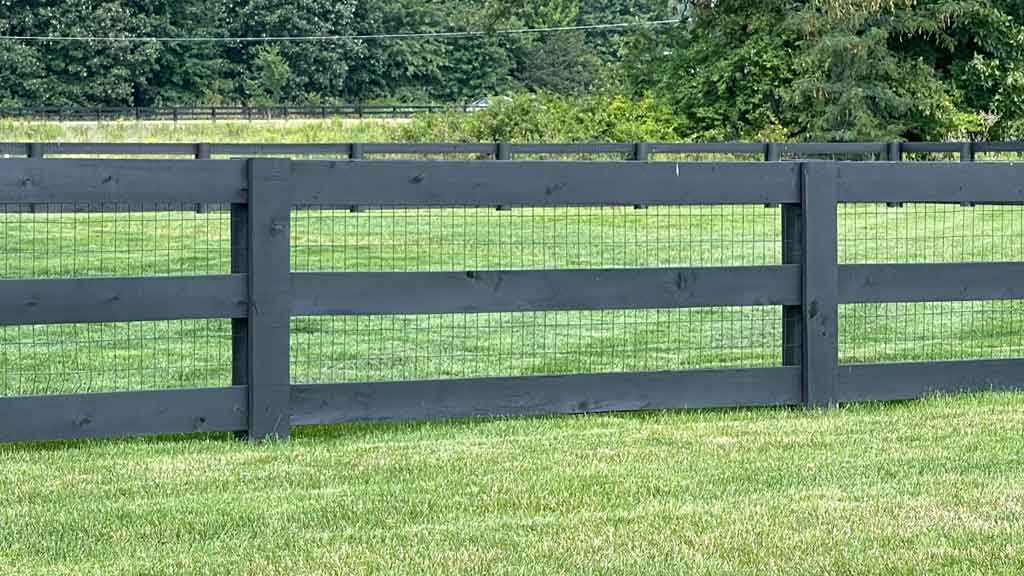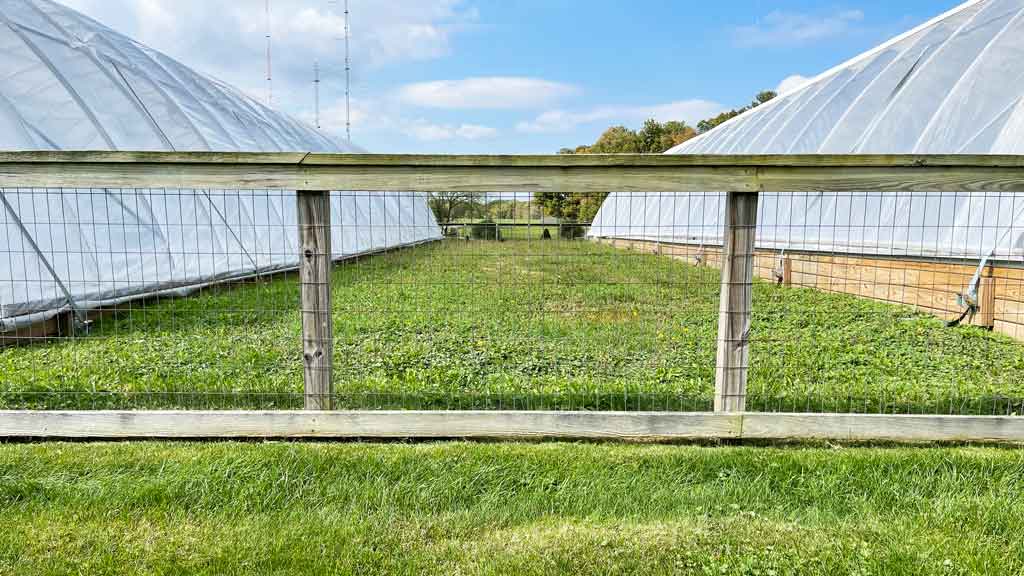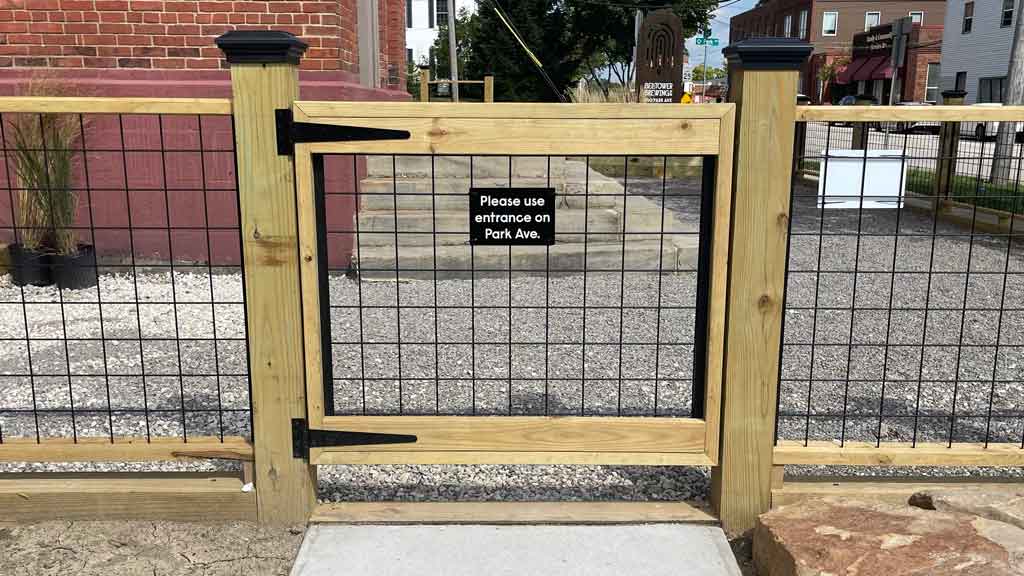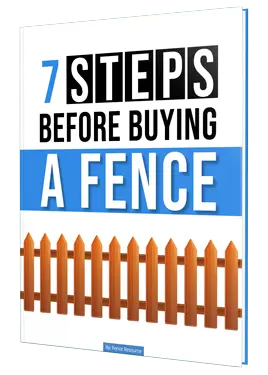Wood and wire fence is a style of custom wood fence with wood framework and wire mesh infill. Also referred to as hog wire fence or wood wire, there are countless wood wire fence designs.
Your choice of materials for the framework and the wire mesh used for the infill will give your version of this popular fence a custom look.
However, the building process remains the same no matter what components you choose.
Wood and Wire Fence Framework

The framework for wood wire fence is very simple. It requires posts and rails. The dimensions for both of these components can be to your liking. There are no right or wrong choices. Go for the look you like the best.
Posts for Wood and Wire
The posts used for wood and wire fence provide the rails and the wire mesh a strong foundation to attach to. We recommend setting them in concrete.
The distance between the posts should be 8′ on center or less. Check local building codes for depth requirements before setting posts.
Leave posts taller than the intended height of the fence. Cut to height after completing the installation.
The actual size of the posts really doesn’t matter. Compared to other types of fence, wood wire fence is lightweight.
The open wire design won’t catch the wind either. So the stress on the posts of this type of custom wood fence will be minimal. Standard posts sizes for wood and wire fence are 4×4, 4×6 and 6×6. The larger the post, the beefier the fence will look.
Rails for Wood and Wire Fence
The rails are the horizontal pieces that connect the posts. Wood and wire uses two rails per section. A top rail and bottom rail.
Just like the posts, you have options in regards to the size of the rails. 2×4 and 2×6 rails are standard sizes. Install the rails an inch taller than the height of the wire mesh infill you plan to use.
This will allow some wiggle room when installing the wire. However, there are options as to where the rails will connect to the posts.
The first and easiest way to attach the rails to the posts on a wood wire fence is on one side of the posts. This will result in the framework of the fence being install off center to the posts.
However, this method is easier when adding wire mesh to the framework. Allowing one continuous piece attached to the length of the fence line.
The second way is to attached the rails in between the post. This takes more precise measuring and cutting of the rails. Furthermore, requiring cutting the wire mesh infill to fit between the posts. Go for the look you desire.
Trim Boards
Trim boards are optional and not required. However, they do add a finished look to the fence. Adding trim boards sandwiches the wire mesh infill between the rails. This adds a clean finished look to the fence.
Trim boards do not have to be the same thickness as the rails. This is because they don’t do anything other than cover up the ends of the wire infill and the fasteners used to attach the infill to the rails.
As a result, trim boards are thinner. Use 1x4s or 1x6s for trim boards on wood and wire fence.
Pro Installation Tip
Install the rails level. Do not try to follow grade when installing wood wire fence using welded wire. The perfect squares and rectangles of the wire mesh infill do not adjust to grade changes well.
Not to mention the look of vertical strands of wire mesh running downhill where they intersect the vertical lines of a plumb post is not appealing. Even worse, is when the wire mesh needs cut between posts resulting in triangular spaces next to them.
If a change in grade is necessary, step the sections of the fence at each post.
Wire Mesh Infill for Wood Wire Fence
The wire mesh infill used for wood and wire fence comes in three styles. Wire fence designs include welded wire mesh, woven wire mesh and steel wire cattle panels.
The hole size in the mesh and the strength of the mesh will determine which one is best for your custom wood fence.
Welded Wire Mesh

Welded wire mesh has vertical and horizontal strands of wire welded together where they intersect. This might sound strong, however, the strands of wire are very thin. As result, making welded wire the weakest option of the three.
However, it is also the least expensive of the wire fence designs options for wood wire fence. Welded wire mesh infill is lightweight and easy to work with. It is easy to cut to size. It can attached to the rails in one continuous piece or cut to fit between the posts.
Because the wire strands are thin, it sandwiches well between rails and trim boards. Welded wire mesh comes galvanized or vinyl coated. Allowing you to choose between silver, green and black colors.
Woven Wire Mesh
Woven wire mesh has vertical and horizontal strands of wire like welded wire mesh. However, there are two major differences.
Woven wire mesh uses heavier gauge wire strands. Therefore making it stronger than welded wire. Also, a special knot ties the strands together at intersecting points. As a result, allowing woven wire to be stretched tighter than welded wire.
However, this only works when the wire mesh infill will be stretched in a continuous line on your wood wire fence.
Woven wire can also be cut to fit between each post. But the only advantage over welded wire when installed this way is the heavier gauge wire.
Welded Steel Cattle Panels

Cattle panels make for excellent infill for wood and wire fences. The heavy duty wire strands are welded together where they intersect. This makes for a rigid panel that can be cut to any width.
There is no need to stretch cattle panels. As a result, allowing it to be installed in a continuous run or between posts easily.
However, because cattle are big, so are the holes in these wire fence designs. Make sure to review the size of the holes in the panels before purchasing them. If you are trying to contain small animals or pets, the spaces will be too large.
Gates for Wood and Wire Fence

The gates for wood and wire fence will be custom to match your design. Because of all the design options, there is not a standard way to construct gates. However, I do have suggestions and tips for building a wood and wire fence gate.
Firstly, don’t make them heavier than they have to be. Heavy gates tend to sag and are cumbersome to open. Use 2×4 framework to keep weight down. Or build a steel framed wood gate.
Secondly, use a cross brace or wire tensioner for extra support. Wood wire fence has a very open transparent look.
I know you want the gates to match, but adding a cross brace will improve the integrity of the gate. At the very least, add a metal cable with turnbuckle to prevent sagging.
Next, don’t go too wide. If a larger opening is required, turn a single gate into a double gate. Two smaller gates will reduce the weight of each gate leaf. They will also be easier to operate.
Use a drop rod or cane bolt to secure one side of a double gate. When access to the larger opening is needed, simply pull the drop rod and open both leafs.
Lastly, make sure the gate post is concrete deeper than the other posts. Gate posts have the burden of supporting the gate. As result, extra stress is put on them.
Make sure to concrete the gate post. Dig a larger diameter hole and make sure it is at least 36″ deep. When a single gate is larger than 4′ wide, upgrade the gate post to a 4×6 or 6×6 post if 4×4 were used on the rest of the fence.
Providing the gate with a solid platform to hang from will give you years of trouble free operation.

